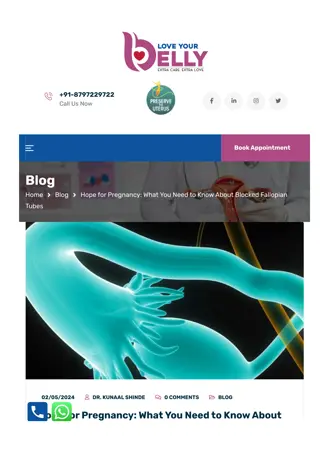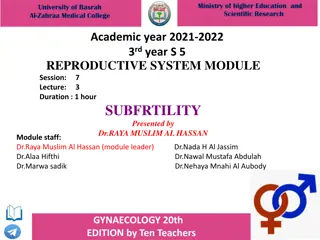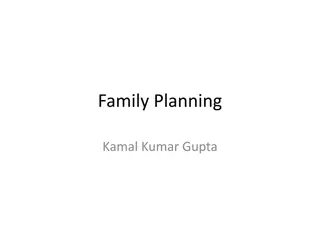Comprehensive Guide to Permanent Family Planning through Vasectomy and Tubal Ligation
Surgical procedures like vasectomy and tubal ligation are effective methods of permanent family planning. This guide covers the definitions, benefits, risks, and techniques associated with male and female sterilization. With detailed information on vasectomy for men and tubal ligation for women, individuals can make informed decisions about their reproductive choices.
Download Presentation

Please find below an Image/Link to download the presentation.
The content on the website is provided AS IS for your information and personal use only. It may not be sold, licensed, or shared on other websites without obtaining consent from the author. Download presentation by click this link. If you encounter any issues during the download, it is possible that the publisher has removed the file from their server.
E N D
Presentation Transcript
PERMANENT FAMILY PLANNING Zenebe Wolde, MD Assistant Professor, Hawassa University Department of Obstetrics and Gynecology
Outline Objectives Introduction Male sterilization Female sterilization Summary
Objectives 1. Define permanent family planning methods 2. Identify male and female permanent family planning methods 3. Describe benefits and risks of permanent family planning methods 4. Explain the techniques of vasectomy and female sterilization
Introduction to Permanent Family Planning Surgical procedure to permanently and intentionally terminate male and female reproductive function Appropriate for men and women who made a fully informed and well considered decision Most are not reversible Vasectomy for men Permanent Family Planning Tubal ligation in women
Vasectomy For men who do not want more children Transection and occlusion of the vas deferens Also called male sterilization, male surgical contraception No interference with sexual performance Outpatient procedure by local anesthesia
Techniques of Vasectomy Scalpel and Non-scalpel Palpate the vas through the scrotum Grasp the vas with fingers or forceps Pull loop of vas and remove segment Ligate one or both ends of the vas Bury the proximal stump
Indications for Delaying Vasectomy Active STIs Swollen and tender testes Scrotal skin infection Bilateral undescended testes
Benefits of Vasectomy Failure is less than 1% Reason for failure can be: Unprotected intercourse soon Failure to occlude the vas Recanalization Safer and more effective than tubal ligation 0.5 deaths per 100,000 vasectomies
Complications of Vasectomy Side effects are uncommon to very rare Testicular and scrotal pain lasting for months Surgical site infection Hematoma
Female Sterilization For women who do not want more children and/or with medical problem Also called tubal sterilization, tubal ligation, voluntary surgical contraception Most widely used globally - 210 million couples and 28% in the US Not popular in Ethiopia only 0.1% Occlusion of the tubes in some form
Timing of Female Sterilization At the time of Caesarian Section Postpartum minilaparotomy Interval minilaparotomy Concurrent with pregnancy termination
Methods of Female Sterilization Abdominal (laparotomy/Minilaparotomy) Vaginal Laparoscopic Hysteroscopic Different surgical approaches
Minilaparotomy for Tubal Ligation Ligation of the fallopian tubes through 3-4cm incision on the abdomen, can be done: As an outpatient procedure By local anesthesia and sedation Minilaparotomy following vaginal delivery: Enlarged uterus, tubes in the mid abdomen, 3-4 cm sub umbilical incision Interval minilaparotomy: Short transverse suprapubic incision Uterine elevator used through the vagina
Indications to Delaying Tubal Ligation Current pregnancy Less than 6 weeks postpartum Severe postpartum or post abortion complications Unexplained vaginal bleeding Pelvic inflammatory disease and STIs Pelvic malignancies
Benefits of Female Sterilization No known side effect Helps to protect against unwanted pregnancy Nothing to remember and no worries about contraceptives again Prevents against pelvic inflammatory disease (PID) May protect against ovarian tumor
Risks of Female Sterilization Few complications Related with surgery, anesthesia, previous surgery, PID, Obesity, and DM 1-2 deaths /100,000 cases 2 pregnancies per 100 women over 10 years Possibility of future regret Young age Lost a child Few or no children Not married/ Marital problems
Counseling on Female Sterilization Counseling is critical: Potential risks Benefits Possibility of later regret Possibility of pregnancy (mostly ectopic)
Summary Permanent methods are irreversible Non-scalpel vasectomy in men and minilaparatomy for women are preferred Permanent methods are less popular in Ethiopia Detailed counseling is essential Rare complications - not related to method
Case study 20 year old woman come to your clinic for family planning She and her husband decided that tubal ligation is best for them. The couple has one child. What important issue would you like to raise during the counseling? Take 3 minutes to reflect
Considerations in the Case Check if it is well thought through Discuss the possibility of future regret as the method is irreversible Mention other alternative family planning methods






























